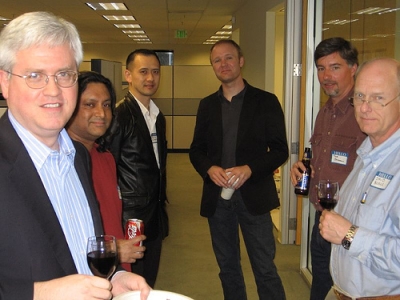Open source routers shine at Vyatta secret society

![]() Yesterday at the Vyatta secret society meeting in San Mateo California, a group of people committed to the idea of an open source router implementation gathered at the offices of Vyatta. Other than the Vyatta employees, the group was comprised of executives, engineers and programmers in the Silicon Valley area from companies like eTrade to Trapeze to XenSource.
Yesterday at the Vyatta secret society meeting in San Mateo California, a group of people committed to the idea of an open source router implementation gathered at the offices of Vyatta. Other than the Vyatta employees, the group was comprised of executives, engineers and programmers in the Silicon Valley area from companies like eTrade to Trapeze to XenSource.

From left to right: Paul Smith - Tasman/Nortel, Atanu Ghosh - XORP Project, George Ou - TechRepublic, Robert Bays - Vyatta CTO, Tom Grennan - Teak Technologies, David Boggs - UC Berkley.
Vyatta is a venture funded startup hoping to bring open source to the highly proprietary world of network routers using a commercial variation of the XORP project. Their hope is to compete with companies like Cisco on the low and medium sized router market using freely distributed software that can turn a commodity PCs and Servers in to a network router.
The Vyatta software router implementation can boot up a stripped down implementation of Linux on any commodity x86 platform computer. Demonstrated at the event was a prototype generic 1U x86 Server with a compact flash card in place of the hard drive. Vyatta currently supports Ethernet and T1 interfaces and will add support for DS3 and T3 interfaces in the near future. The 3rd party T3 cards are about 1/2 to 1/3 the cost of similar T3 cards from Cisco.
Routing protocols such as BGP, OSPF, and RIP are supported which means it will interoperate with a very wide range of routers from all the different manufacturers. Future feature sets will include capability like SSL VPN which allows tunneling of VPN traffic through restrictive firewalls and proxy gateways.
One other exciting aspect of Vyatta is that it can run in a Virtual Machine environment with VMware or XenSource. This means that complex network topology can be modeled in a fully simulated environment to optimize the design and test phases of networking. I've already been testing Vyatta in VMware and will probably be testing in XEN as well in the near future. Since proprietary routers won't run in a virtualized world, it gives Vyatta a unique advantage to spread its market share. If Vyatta succeeds, it will help bring new competition and innovation in to the proprietary world of networking.